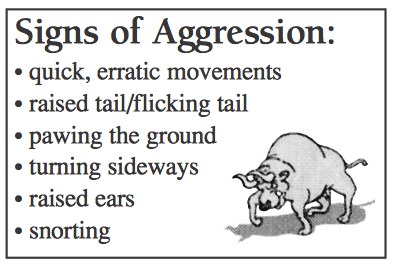When dogs become aggressive the hair on the back of their necks and backs raise up. Stallions prick (lift up) their ears and wag their tails. Bulls, buck and rams paw the ground with their front feet. Birds and reptiles puff themselves up to look larger than they really are.
Although house pets such as dogs and cats can be very calm and friendly to their masters and friends, they will change their behaviour when a new-born litter arrives. Special attention must be given in such a case to their behaviour; they may sense a threat to their young when suddenly approached. Look out for their warning signals like a grunt or hiss to tell you to back off.
In a farm situation, it is necessary to report defensive behaviour to the supervisor. Sometimes animals can act defensively for other reasons than the obvious.
Animals can exhibit discomfort in different ways when exposed or kept under stressful and unfavourable conditions. Some of these symptoms can be:
Pacing and route tracing: This happens when animals are kept in a place where they cannot escape such as a cage. For example, hens are kept in a cage pace because they do not have access to a social environment.
Rocking, swaying and weaving: This kind of behaviour shows boredom in animals.
Rubbing: Animals such as pigs can start rubbing their heads or even bang their heads leading to injuries when restricted in a narrow single stall.
Pawing or stall kicking: When horses are frustrated because of not getting the food they will start pawing which can lead to leg injuries.
Head-shaking and nodding: Caged domestic fowl or caged birds can start showing this kind of behaviour because they cannot escape the obvious observer when frustrated in their movements.
Eye-rolling: Is shown by calves in pens.
Sham-chewing: Where no litter is available this behaviour is shown by pigs by chewing when there is no feed in the mouth.
Licking or crib wetting: An animal repeatedly licking its own body can lead to the abrasion of the tongue. This condition is caused by inadequate food.
Drinker pressing: Caused by boredom. The animal tries to reduce boredom by pressing the drinker repeatedly without drinking the water.
Feather pecking: Often seen in poultry due to social dominance in intensive husbandry due to poor ventilation, high temperatures, low humidity, excessive population density and insufficient space.
You have thus learnt that animals have different ways of showing discomfort, and animals have different ways of acting defensively. Now, how should you respond to bring defensive behaviour under control?

Click here to view a video that explains cattle behaviour and handling.